-
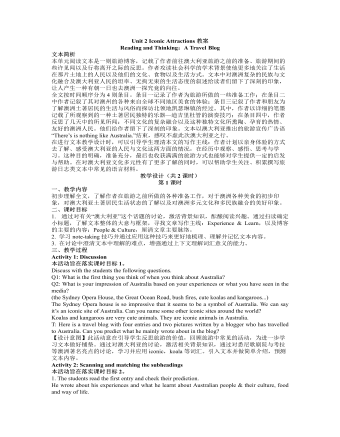
新人教版高中英语选修4Unit 2 Iconic Attractions教案
帮助学生通过讨论与对主题的提升,反思自己的旅游方式,以便做出更优化的安排,在今后的旅程中有更多的收益。 Activity 2: Further discussion of the 6 elements above and supplement of more background knowledge 本活动为实现课时教学目标2。 1.Target Q: The writer’s clear target of traveling, meeting the people and experiencing the culture, is closely related to his major in social studies. Then what is social studies? Social studies is a part of a school or college curriculum concerned with the study of social relationships and the functioning of society and usually made up of courses in history, government, economics, civics, sociology, geography, and anthropology. (Dictionary by Merriam-Webster) Reflection: When you go out to travel, what targets do you usually have in mind? 2.Research Q: Suppose you are traveling to Hangzhou during the school holidays, how will you do research on the city? (surf the internet, read books or travel brochures, consult friends, ...) What information will you be interested to know? (location, iconic sites, local cuisines, interesting customs, shopping malls ...) 3.Abandonment To make the most of time, we have to learn to abandon so that we can accomplish our plan. What will you be interested in doing if you go to Hangzhou if you have a week’s time? What if you only have 2 days? 4~5. Venturing & Experiencing Q: What did he venture to do during the trip? What new experiences did he have? In Sydney: attend his first open-air barbecue, enjoy many different but yummy meals In Catherine: observe the life and customs of the aborigines appreciate their music & try the musical instruments: the didgeridoo
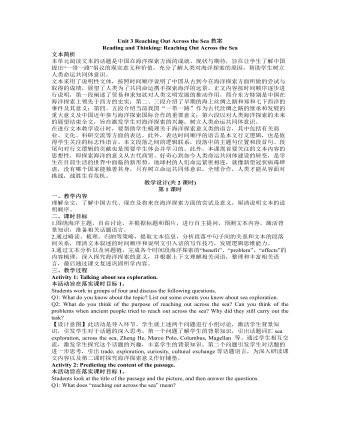
新人教版高中英语选修4Unit 3 Reaching Out Across the Sea教案
本活动旨在落实课时目标3。 Think about the following questions and talk about your own attitude in pairs.Q1: As for this topic,what impresses you the most in the passage?Q2: What do you think of the future of China’s further exploration in sea? Are you in favor of the further exploration?Why or why not? 【设计意图】该活动是一个完全开放性的活动,每个学生都会有不同的答案。运用迁移所学,自由口头表达自己对海洋探索的态度。对于中国海洋探索的未来,每个人的想法是不一样的,有乐观,有担忧,有认为值得投入,也有认为不值得付出太大代价,这里给学生自由表达的空间只要学会有支撑自己观点的事实就可以了,进一步培养学生批判性思维和正确的价值观。 Assignment: 此任务旨在迁移一、二课时所学,培养学生辩证分析问题的能力。 Write about your idea of the future of China’s sea exploration. And add your attitude towards the effort China have made in sea exploration. You’re expected to use the language and the writing technique learnt in the passage.
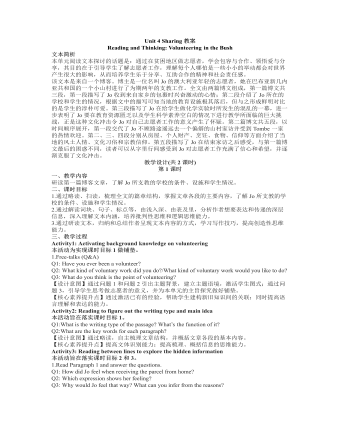
新人教版高中英语选修4Unit 4 Sharing教案
【核心素养提升点】学会将抽象信息进行可视化表达,提高信息处理能力和分析、推理等高阶思维品质;在跨文化交际中学会以国际视野接受和包容不同的文化。 5.Read Paragraph 2, draw a mind map and answer the questions. Q1:What did Jo learn about Tombe’s life? Q2:What kind of life do the natives lead? Read paragraph 2-5 and draw a mind-map. (Focus on accommodation, possession, diet and belief) 【设计意图】引导学生利用思维导图和问题链等形式来厘清当地人的生活方式,更好地处理和归纳信息 【核心素养提升点】提高信息处理能力、分析和归纳能力,包容异国文化、扩展国际视野。 6.Read Paragraph 3 and answer the questions. Q1:What was Jo’s feeling upon arriving her own home? Q2:Why would she feel that way? Q3:Do you think “It was such a privilege to have spent a day with Tombe’s family”? 【设计意图】通过提问,让学生理解Jo的苦并快乐的心情,并通过对“It was such a privilege to have spent a day with Tombe’s family”这句话的理解,体验志愿者生活的伟大。 【核心素养提升点】学会对信息的综合和归纳,从而理解作者所表达的观点。 Activity4: Summarize the change of Jo's feelings
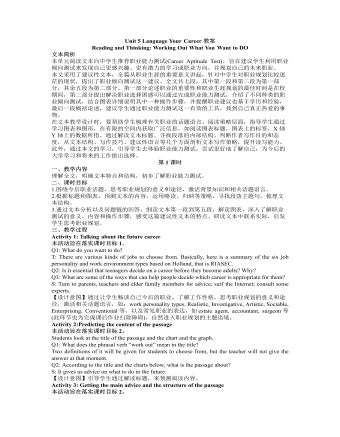
新人教版高中英语选修4Unit 5 Language Your Career教案
本单元阅读文本向中学生推荐职业能力测试(Career Aptitude Test),旨在建议学生利用职业倾向测试来发现自己更感兴趣、更有潜力的学习或职业方向,并规划自己的未来职业。 本文采用了建议性文本,全篇从职业生涯的重要意义讲起,针对中学生对职业规划比较迷茫的现状,提出了职业倾向测试这一建议。全文共七段,其中第一段和第二段为第一部分,其余五段为第二部分。第一部分论述职业的重要性和职业生涯规划的最佳时间是在校期间,第二部分提出解决职业选择困惑可以通过完成职业能力测试,介绍了不同种类的职业倾向测试,结合图表详细说明其中一种操作步骤,并提醒职业建议也基于学历和经验,最后一段概括论述,建议学生通过职业能力测试这一有效的工具,找到自己真正热爱的事物。 在文本教学设计时,要帮助学生梳理有关职业的话题语言。阅读策略层面,指导学生通过学习图表和图形,在有限的空间内获取广泛信息,如阅读图表标题,图表上的标签,X轴Y轴上的数据所指。
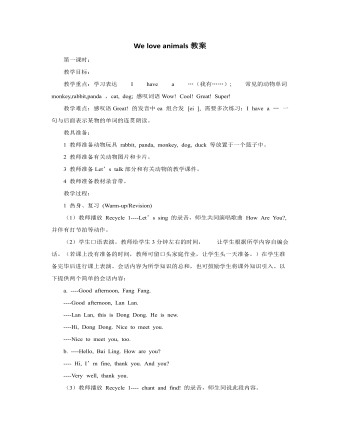
人教版新课标PEP小学英语三年级上册We love animals教案
(1)游戏:向它那儿跑去(Run to it!)首先,用图片和词卡练习本课的6个新单词。学生边读老师边把卡片贴在黑板上。将全班分成两队。给学生下一个Run to the bird.这样的指令。每队的第一个学生向带有鸟的图卡和词卡的地方跑,并且用手摸一下这两张卡片。哪组学生先摸到卡片就给他们队得一分。教师也可以用本课刚学的指令:Walk to….Jump to ….Fly to….等指令学生用相同的动作走(跳,飞)到卡片前。(2)教师将Let’s do的图片打乱顺序,让学生听指令,选出正确的图片。(3)游戏:照我说的做(Do as I say)教师发指令,全班同学起立做动作。做错的同学随时坐下。最后,哪组站着的同学多,哪组获胜。教师参考指令: Climb like a monkey/bear.Jump like a squirrel/rabbit.Walk like an elephant/duck.Hunt like a mouse/pig.Act like a cat/dog.Fly like a bird.为了增加游戏的难度和趣味性,教师可逐渐加快指令的速度。4.课堂评价(Assessment)做活动手册本单元第5部分的练习。方法和步骤参考第一单元。
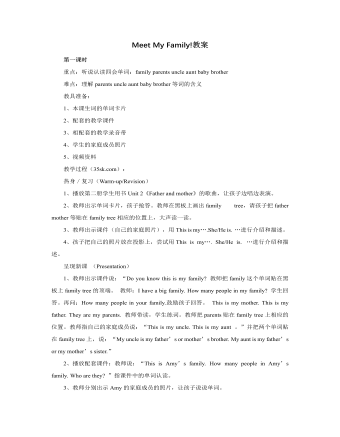
人教版新课标PEP小学英语四年级上册Meet My Family!教案
教案点评: 本课时在上一课时的基础上,进一步在情景中学习句型Is this your...? He/She looks... What’s he/she? They look... Are they...? 本课时的内容和学生的实际生活贴近,学生对该话题感到亲切,教学新句型时教师运用学生的家庭照片,在师生的对话中自然的呈现新知和操练句型,有助于学生更好的掌握和操练对话。本堂课教学层次分明,教师引导适当,发挥了学生在学习中的主体地位第六课时重点:单词nurse, doctor, farmer, driver的拼写。难点:I’m going to be a…教具准备:1.图片nurse, doctor, farmer, driver2.教材相配套的教学录音带3.单词卡片教学过程(35sk.com):一 热身/复习(Warm-up/Revision)1.口语练习:How many people are there in your family?Who are they?What are they?2.让学生改编B部分的chant, 然后表演出来。教师对表现出色的应即使给予奖励。二 呈现新课 (Presentation)1.教师出示表示表职业的单词卡让学生认读,并贴在黑板上。2.做找朋友的游戏。让学生把图片贴到相应的单词下。
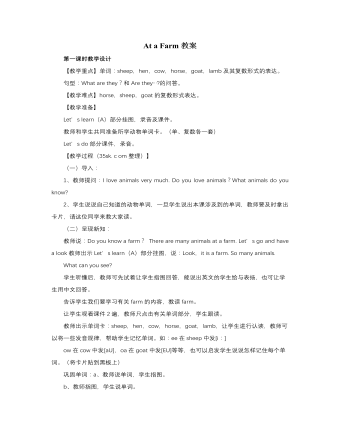
人教版新课标PEP小学英语四年级下册At a Farm教案
(二)新课呈现:学生以小组的形式指着挂图汇报,每组只谈论一种动物。(教师为尽可能多的学生提供对话机会,鼓励学生尽可能不重复别人说过的。)在对话的过程中,教师将单词卡片cat,dog,rabbit,duck,pig适时呈现给学生,让学生拼读单词。然后启发学生将每个单词中的元音字母的发音说出来,从而帮助学生记忆单词,同时为Pronunciation的教学进行铺垫。教师适当讲解单词拼写中需特别注意的地方。rabbit双写b;duck中ck发[k]的音。做找朋友的游戏:方法一:教师说单词:cat,dog,rabbit,duck,pig,分别请五个学生站到前面做出5种动物的动作;将5个单词的卡片面朝下分别发给5个学生,教师说Start!5名学生分别翻开卡片,根据单词意思到前面去找自己的朋友。教师对完成准确而且速度快的同学进行表扬。方法二:教师将cat,dog,rabbit,duck,pig的图片和单词卡片分别发给十个同学,看看谁能在最快的时间内找到自己的朋友。教师要表扬配合最密切的两个同学。
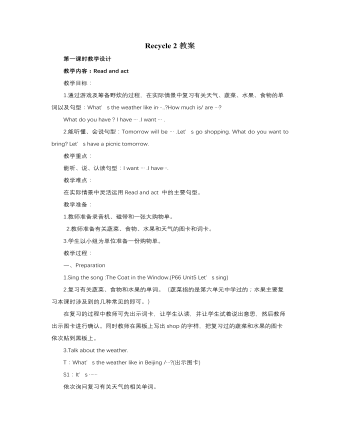
人教版新课标PEP小学英语四年级下册Recycle 2教案
第一课时教学设计教学内容:Read and act教学目标:1.通过游戏及筹备野炊的过程,在实际情景中复习有关天气、蔬菜、水果、食物的单词以及句型:What’s the weather like in…..?How much is/ are …?What do you have ? I have … .I want … .2.能听懂、会说句型:Tomorrow will be … .Let’s go shopping. What do you want to bring? Let’s have a picnic tomorrow.教学重点:能听、说、认读句型:I want … .I have….教学难点:在实际情景中灵活运用Read and act 中的主要句型。教学准备:1.教师准备录音机、磁带和一张大购物单。2.教师准备有关蔬菜、食物、水果和天气的图卡和词卡。3.学生以小组为单位准备一份购物单。教学过程:一、Preparation1.Sing the song :The Coat in the Window.(P66 Unit5 Let’s sing)2.复习有关蔬菜、食物和水果的单词。(蔬菜指的是第六单元中学过的;水果主要复习本课时涉及到的几种常见的即可。)在复习的过程中教师可先出示词卡,让学生认读,并让学生试着说出意思,然后教师出示图卡进行确认。同时教师在黑板上写出shop的字样,把复习过的蔬菜和水果的图卡依次贴到黑板上。
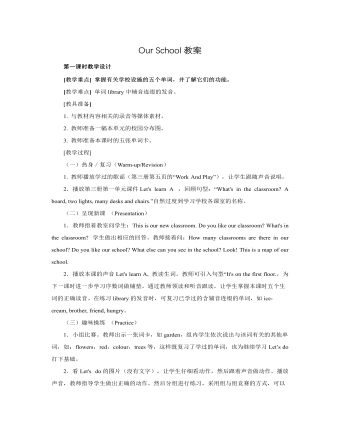
人教版新课标PEP小学英语四年级下册Our School教案
教学重点:Read and write 中的四个四会单词以及问句“Is this a teacher’s desk?”及其答句“Yes, it is.”在四线格中的正确书写。教学难点:拼读单词picture,在四线格中书写句型“Is this a …?”以及总结元音字母a的发音规则。教具准备:1.与教材内容相关的课件、声音、图片等媒体素材。2.教师准备相关的词卡。3.学生准备白纸和彩笔。教学过程(35sk. c om整理):(一)热身/复习(Warm-up/Revision)1.师生合唱该单元的歌曲和歌谣,边歌边舞。2.请学生表演Story time中的对话。3.猜谜语:教师给学生出一些简单的谜语,如:Jack is in a room. There are many books in it. He can see many students. They are reading books. They are quiet. Where is Jack?(二)呈现新课 (Presentation)1.请学生观察Read and write部分的情景图,预先空出来需要书写的四会单词,让学生独立思考,填充对话。
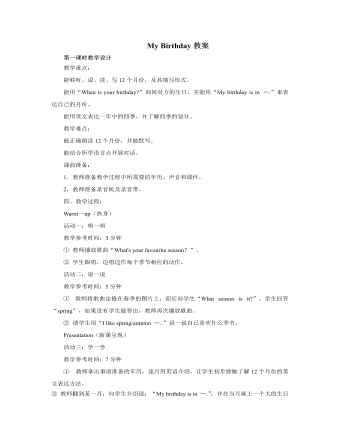
人教版新课标PEP小学英语五年级下册My Birthday教案
① 教师询问学生“What day is today?”,学生说出“Today is …”。而后又问学生:“What’s the date?”,帮助学生说出今天的具体日期:“It’s …”。 ② 让学生拿出课前准备的年历(最好是学生自己制作的),教师随意指着某天询问学生:“What’s the date?”,而后请学生拿着年历相互用“What’s the date? It’s ….”进行问答练习。③ 教师拿着年历从一月开始问学生:“Who has a birthday in January? Please stand up.”,而后教师问起立的学生:“What’s the date?”,让一月份生日的学生答出具体日期。④ 请若干名学生代替老师进行提问,从二月到十二月。活动四:Let’s talk教学参考时间:8分钟① 教师播放对话录音两遍,而后提问:“When is Sarah’s birthday? When is Zhang’s birthday?”,学生根据对话内容回答出:“Sarah’s birthday is in October1st. Zhang’s birthday’s is in March12th.”。 ② 学生跟读对话,两人一组做对话练习。 ③ 学生根据同学的生日组织一个新的对话,教师请若干组展示他们的对话。
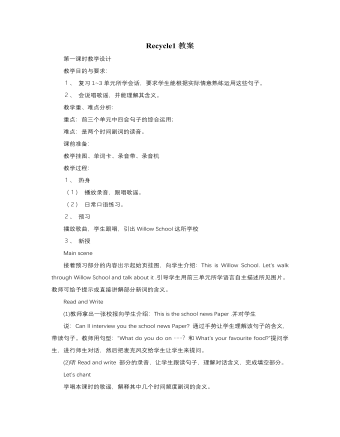
人教版新课标PEP小学英语五年级上册Recycle1教案
巩固延伸尝试与他人进行书信交流第三课时教学设计教学目的与要求:1、 能够使用所学四会句子完成Task time中的采访任务。2、 能够理解Let’s play中的问题并做出正确回答。3、 能够听懂、会唱歌曲“My Favourite Day”。教学重、难点:重点、难点为复习并使用四会句子完成Task time中的采访任务,并展示个人报道。课前准备:教学挂图、录音带、录音机、简历表教学过程:1、 热身(1) 放第二单元歌曲,学生跟唱,复习有关一周七天的单词。(2) 日常口语练习。2、 预习:放录音,欣赏歌曲。3、 新授Task time(1) 就歌曲内容向学生提问:Do you like weekends? What’s your favourite day? 引导学生回答:My favourite day is Saturday/Sunday. 并请学生说明理由,表述周末活动。出示采访表,回答问题。(2) 让学生参照学生用书的采访表进行小组交流,并在最短的时间内填充表格,然后每组派代表做汇报。Let’s play看图片,指导学生先读懂句子,再回答问题。Let’s sing学生理解并学唱本单元歌曲“My Favourite Day”.巩固延伸:采访教师;画画猜人
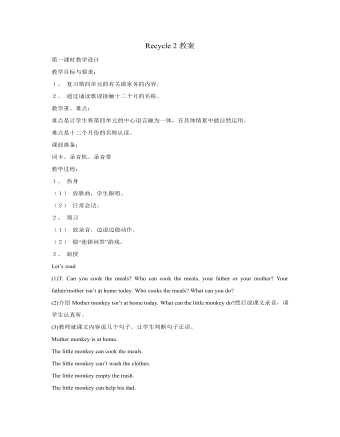
人教版新课标PEP小学英语五年级上册Recycle2教案
教学目标与要求:1、 通过活动和复习句型,介绍及动作短语等。2、 学唱歌曲。教学重、难点:重点为复习巩固介词及存在句型。难点为正确区分内容相近的图片。课前准备:词卡、录音机、录音带、图片教学过程:1、 热身(1) 放歌曲录音,学生跟唱。(2) 师生进行日常会话。2、 预习做“按我说的做”游戏。3、 新授(1) 看图片,问:Where is the …? Ss: It’s in /on/over…(2) 做“猜一猜”游戏。(3) 两人一组完成Pair work,连一连,说一说。(4) 听录音,完成练习。录音原文如下:There are mountains behind her village. There is a river near her house. There is a new air-conditioner in her bedroom. She cleans her bedroom every day.There is a lake near his village. There are many trees in front of his house. There is a big trash bin in his kitchen. He can cook tasty meals.There is a forest near his village. There is a road beside his house. There is a man under a tree. He often waters the flowers.There are many Paths in her village. There are new curtains on the window of her house. There are many new skirts in her closet. She washes the clothes every weekend.巩固延伸:做“幸运摸奖”游戏
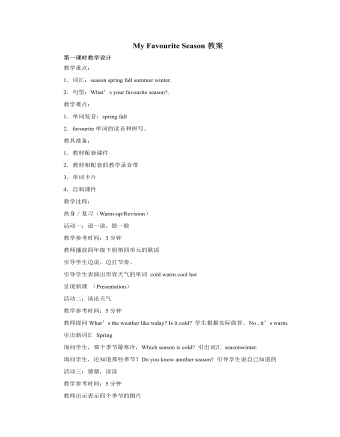
人教版新课标PEP小学英语五年级下册My Favourite Season教案
(三)趣味操练 (Practice)活动六:猜一猜教学参考时间:5教师说:Guess what’s my favourite season. Why?学生猜测:It’s winter. Because you can skate. 教师给予肯定或否定的答案然后邀请另一名孩子起来,大家继续猜测活动七:传话游戏教学参考时间:3分钟教师在每个小组第一个同学耳边轻声说一个句子:I like summer, because I can swim./I like fall, because I can find many beautiful defoliation.(落叶)/….每个小组传话,看谁传的又快又好每组的最后一个汇报你听到的句子(四)巩固和扩展(Consolidation and extension)活动八:Link and say教学参考时间:5分钟完成活动手册P13—3两人一小组,分别说说每组图代表的季节,服装,和事情教师提问,What would you like to do in spring/in summer/in winter/ in fall?,请孩子回答。两人一组问答,根据你听到的连出出对方喜欢的季节事情两个人交换书对答案活动九:Let’s do a survey 教学参考时间:5分钟完成活动手册P13—4自己认读范例对话,明确题意小组调查(6人)各小组展示答案活动十:试一试(Let’s try)教学参考时间:5分钟教师播放录音,学生理解再听录音,选择你听到的图
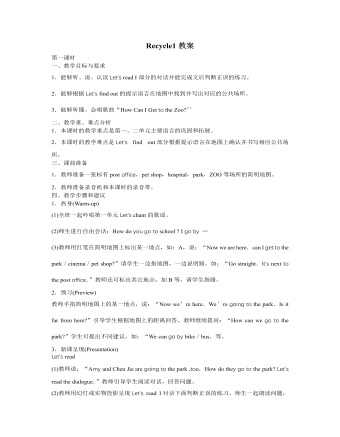
人教版新课标PEP小学英语六年级上册Recycle1教案
1.热身(warm-up) (1)全班齐唱歌曲“How call I Get to the Zoo?’’ (2)师生一起吟唱第一单元的歌谣,要求学生一边吟唱,一边用手打节拍。 2.预习(Preview) 教师对学生有关My Dream Vacation的短文做出总体评价,并请几名写得有创意的学生朗读他们的短文,教师针对其内容提问,如:“Where are you going? What are you going to do? How are you going to there等。教师根据课前的准备,在最后一名学生朗读完文章并回答了问题以后,简化并板书该学生的回答,将其改编成为一首小歌谣,如: Where are you going? What are you going to do? I’m going to the ZOO to see the monkeys. I’m going by bike.I’m going On foot. I live near the ZOO.So I won’t take a train. 教师拍节拍示范朗读自己改写的新歌谣,学生模仿吟唱新歌谣。 3.新课呈现(Presentation) Let’s chant 在以上活动的基础上,教师放Let’s chant部分的录音,学生静听并试着跟读,再看着文字吟唱。师生可进行问答式吟唱,并在小组间展开比赛。 Listen and match
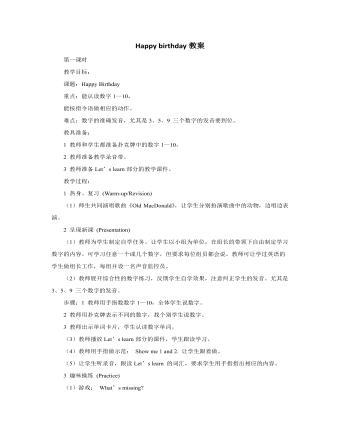
人教版新课标PEP小学英语三年级上册Happy birthday教案
(2)猜猜看每次请一个同学在黑板上画一种刚学到的物品,他每画一笔,就请班上的同学用英语猜他画的是什么。如猜得正确,就请下一位同学再重新开始画另一种物品。(3)Let’s rhyme.将所学的单词替换第一单元的Let’s chant中的文具。教师将全班分为两大组,教师举图片提示,如第一组说:I have a balloon.第二组一起说:Me too. 拍手,举第二幅图时两组交换。以此类推。(4)教师将单词的图片先面朝上贴在黑板上,给学生20秒时间记住这些单词,然后每张图卡用1张彩色纸盖上。学生要先说出彩色纸的颜色,再说出下面卡上的词。待学生熟悉后,可加大游戏难度,将盖着彩色纸的图卡在(黑板上)打乱,进行游戏。(5)让学生听录音,边说边做Let’s do部分的活动。(6)教师将Let’s do中的图卡打乱顺序,贴在黑板上,教师说一个指令,请学生指出正确的图片。正确的可为本组赢一分。
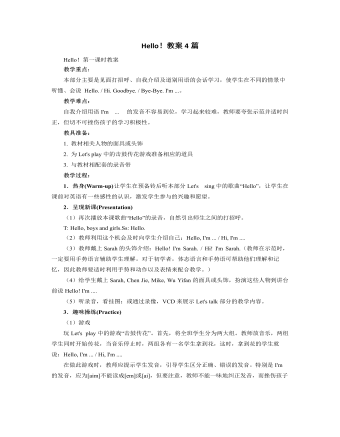
人教版新课标PEP小学英语三年级上册Hello!教案4篇
(3)通过游戏Simon says 来练习以show, open, close, put, carry 所引导的祈使句。教师发指令学生做动作。但只有听到老师带有Simon says的指令时,才能做出相应的动作,否则就是失败。失败的同学退出游戏。(4)听Let's chant的录音,学生边听边做,逐渐过渡成边听边说边做,最后独立说做,并进行比赛。4. 课堂评价(Assessment)做活动手册本单元第5部分练习。学生根据录音,圈出所听到的文具。具体方法和步骤参考如下:(1)学生看图,用英语说出图中每样文具物品。(2)教师讲解题目的意思并指导做的方法。(3)学生听录音做练习。(4)再放录音,在教师的指导下让学生一句一句地跟读并互相核对答案,并说出所圈的文具,再通过给花朵涂色进行自我评价。5. 扩展性活动(Extensive activities)选词游戏。将学生分为六组,每组各派一个选手,教师说单词,选手快步跑到讲台前,找到所说单词,并举起大声读出,正确为胜。
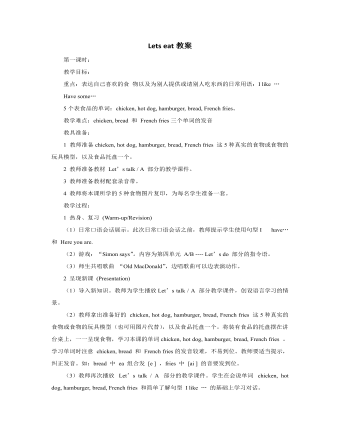
人教版新课标PEP小学英语三年级上册Lets eat教案
教师将本课A、B部分所学单词的图片卡贴在黑板上,找两个学生各手持一把新苍蝇拍,教师读出一个单词,学生就要马上找出来并拍立一下。第一个拍的学生获胜。(4)教师准备一个小场景:将所有学过的食品及饮料或模型放在一个铺着台布的桌上,请学生根据A、B部分的Let’s talk进行自由会话。2.新课展示(Presentation)(1)本课时Let’ s learn中的单词认读教学,可继续采用A部分第二课时的教学方法,利用课件,让学生利用已掌握的拼读规则,认读和学习新单词。(2)让学生听Let’s learn的录音,一边听,一边指着书上相应的图,力求做到“眼到,手到,口到,心到”。(3)用一组连贯的动作教Let’s do中的动词Pour,smell,taste,drink。首先,教师左手端着一个茶壶,右手拿一茶杯,对全班说:Look!I’m pouring the tea. Pour the tea.(边倒茶,边说两遍)。
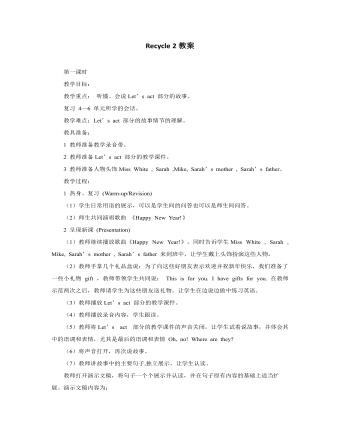
人教版新课标PEP小学英语三年级上册Recycle 2教案
3 趣味操练 (Practice)(1)请学生拿出他们事先准备的材料,指导学生按步骤进行摇摇乐的制作,每句话中的第一个动作都是教师要强调的部分,一定要配合手势,帮助学生理解和记忆。教师可适当给学生充分的时间,让学生用颜色笔将摇摇乐画得更漂亮些,有条件的话,可以用相机将学生的作品拍下来,有机会可以展览。(2)让学生跟着录音一起唱歌曲 Happy New Year,可以在唱歌时打节拍或边唱边舞。4 课堂评价 (Assessment) 做活动手册本单元4、5 部分的练习。本次评价要与课本上的4—6单元评价相结合,让学生自己动手填写评价表,评价自己。5 扩展性活动(Add-activities)新年的时候将歌曲 Happy New Year唱给爷爷奶奶,爸爸妈妈听,祝贺他们新年快乐!板书设计:Recycle 2Let’s make 部分的制作流程图Happy New Year! (一月一日的日历)
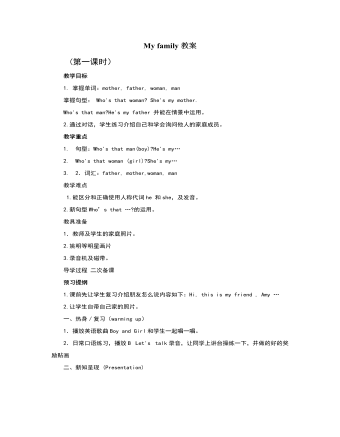
人教版新课标PEP小学英语三年级下册My family教案
1.能够听、说、读、写字母H h, Ii,并能听说认读以这些字母为首字母的单词:hamburger, hot dog ,ice-cream, ice.2.听懂Let’s do 中的字母和短语,并做出相应的动作。如:A B C, look and see.3.听懂Story time 的内容。教学重点 掌握字母H h, I i单词:hamburger, hot dog ,ice-cream, ice。教学难点 1.能够听懂一些指令性短语,并做出相应的动作。2. Story time 的内容教具准备 1.本课时相关的单词卡和图片2. 教材相配套的教学录音带导学过程 二次备课预习提纲1. 课前了解一些食物英语的名称。2. 课前先让学生复习三年级上册FoodPart A Let’s Learn 部分的单词:cake ,bread, chicken…一.热身/复习(warming up)1. 游戏:找朋友将学过的七个字母按大小写分开,一部分学生拿大写字母卡,一部分拿小写字母卡。让拿大写字母卡的学生分别起立读出手中的字母,那对应小写字母卡的学生跟到他前方举起手中的字母,说:I’m… 两人握手2.让学生听三年级上册Part A Let’s Learn部分的录音,了解相关的食物的名称。.
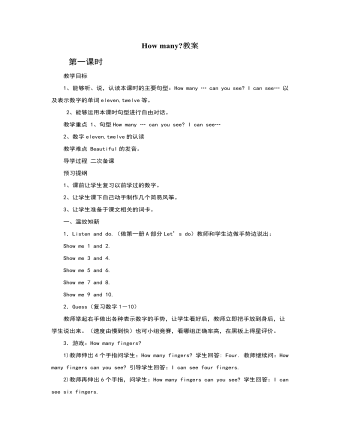
人教版新课标PEP小学英语三年级下册How many教案
一.温故知新1.教师播放“One, two, three, four, five”歌曲的录音带,让学生跟随录音一起唱。2.复习数字1-151)报数:教师让学生从1-15按顺序用英文报数,如果前一个学生报到15了,那么下一个学生就要从1再开始。2)游戏:叫号。教师把写有one —fifteen的单词卡发给学生,教师随意说数字,谁拿着相应的单词卡,谁就站起来并大声读出该单词。3.操练句型How many … can you see? I can see…和How many… do you have? I have…(使用15以内的数字)二.新课呈现 1.教师将1-15的数字卡贴在黑板上,用其中的两张组成一个算式,在两张数字卡的中间写上“+”号,其和为15以内,让学生去计算,如Ten and five is fifteen.2.让学生两人一组,一个学生摆算式,另一个学生用英文说出结果。3.教师出示算式卡,如Nine and seven,让学生快速说出两数之和,并请最先说出答案的学生将算式用数字形式写在黑板上,在单词卡中找到相应的单词贴在和的位置上。

